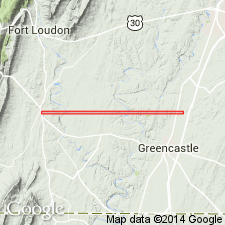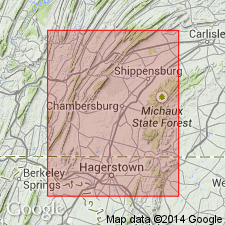
- Usage in publication:
-
- Mercersburg formation
- Modifications:
-
- Named
- Dominant lithology:
-
- Limestone
- Metabentonite
- AAPG geologic province:
-
- Appalachian basin
Summary:
Named the Mercersburg formation for Mercersburg, Franklin Co., south-central PA. Includes beds formerly included in middle part of Chambersburg limestone. Consists of dark-gray, thin irregular and thick even-bedded limestone with base at bottom of drab cuneiform siltstone zone containing metabentonite. Thickness is 500 feet. Overlies Shippensburg formation and underlies Greencastle formation. In western belts, in Cumberland Valley, unit converges with Greencastle formation and it is separated from the Shippensburg by the Hatter limestone and Snyder member of the Benner limestone. The Mercersburg is of Middle Ordovician age.
Source: GNU records (USGS DDS-6; Reston GNULEX).

- Usage in publication:
-
- Mercersburg formation
- Modifications:
-
- Principal reference
- Revised
- Redescribed
- Dominant lithology:
-
- Limestone
- AAPG geologic province:
-
- Appalachian basin
Summary:
Revised the Mercersburg formation by stratigraphically extending the base of the formation to include beds from the top of the Shippensburg formation. Consists of dark-gray, fine-grained, thin crinkly and thick evenly bedded, blue gray weathering limestone with an interval of tan to medium-gray, slabby, buff weathering limestone at base. Five metabentonites are recognized. In eastern belts, unit is divided into the Housum member below and Kauffman member above. Thickness is 235 feet at type locality and thins to the northeast. Contact with underlying Shippensburg formation is marked by prominent irregular, partly silicified bedding surface. Disconformably underlies the Oranda formation; contact marked by prominent basal calcarenite in the Oranda. Type locality is described.
Source: GNU records (USGS DDS-6; Reston GNULEX).
For more information, please contact Nancy Stamm, Geologic Names Committee Secretary.
Asterisk (*) indicates published by U.S. Geological Survey authors.
"No current usage" (†) implies that a name has been abandoned or has fallen into disuse. Former usage and, if known, replacement name given in parentheses ( ).
Slash (/) indicates name conflicts with nomenclatural guidelines (CSN, 1933; ACSN, 1961, 1970; NACSN, 1983, 2005, 2021). May be explained within brackets ([ ]).

